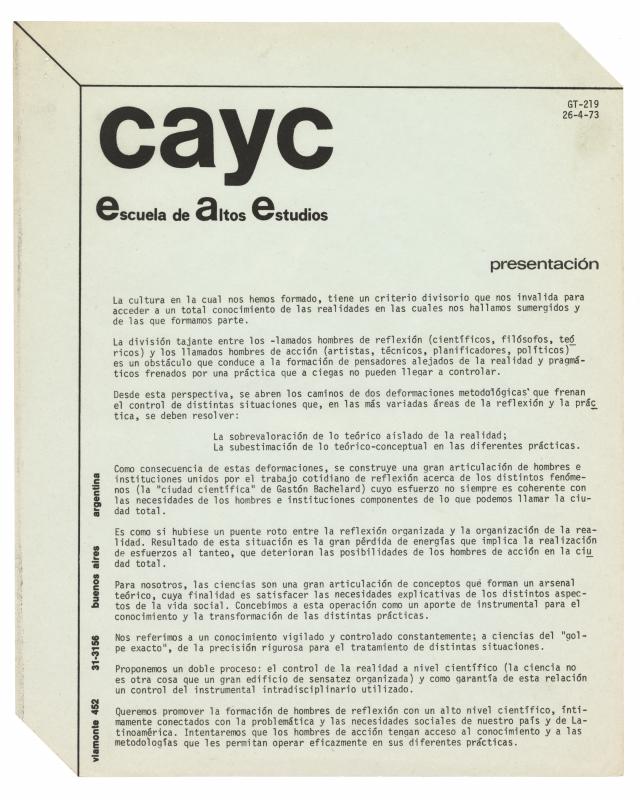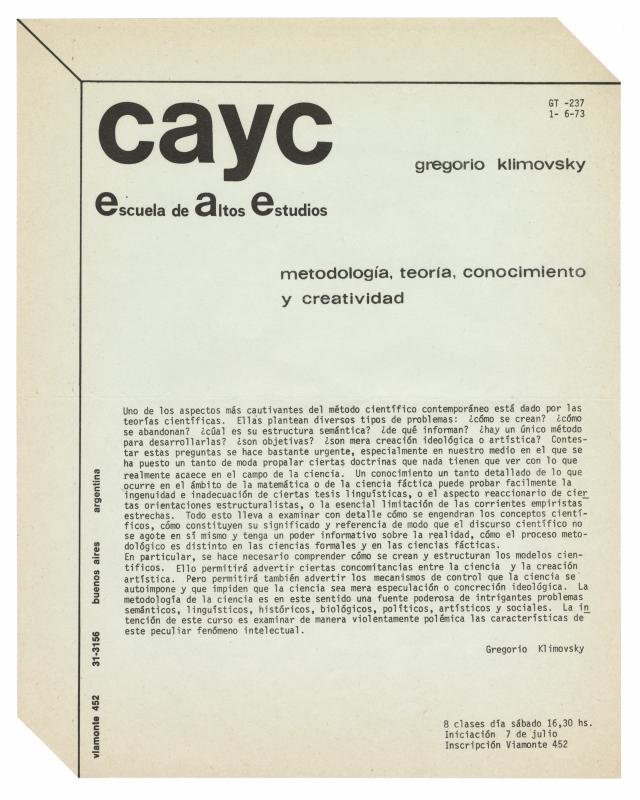Ever since it was founded, the CAYC (Centro de Arte y Comunicación), helmed by the cultural promoter, artist, and businessman Jorge Glusberg, was intended as an interdisciplinary space where an experimental art movement could flourish. The establishment of collaborative networks connecting local and international artists and critics played an important role in this process. In addition to the exhibitions, a program of different activities exposed attendees to the latest in art and scientific thinking. According to Glusberg, the coordination between theoretical thinking and artistic practice was an essential part of social change.
During the military dictatorship of General Juan Carlos Onganía, the CAYC became a cultural home for the Fundación de Investigación Interdisciplinaria, a space that welcomed a group of dissident professors from the Facultad de Arquitectura y Ciencias Exactas de la Universidad de Buenos Aires after the military takeover of the university in what came to be known as “La Noche de los Bastones Largos” in June 1966. In its early years the center organized a variety of activities with intellectuals that contributed to the circulation of ideas from different disciplines (analytical philosophy, mathematical logic, epistemological problems, psychology, semiotics, and linguistics), which had been excluded from official circles.
The center’s interest led to the creation of the Escuela de Altos Estudios (EAE) in early 1973. The objectives described in the relevant newsletters (GT-201; doc. no. 1478752, GT-201- A; doc. no. 1478753, GT-224; doc. no. 1478771, GT-219; doc. no. 1478755) were apparent in the activities organized by the EAE (some of which were more technical than interdisciplinary), as well as in the art produced by artists associated with the center. This initiative was an expression of the mood of openness of the “Cultural Spring” that flowered during the brief democratic presidency of Héctor J. Cámpora, which lasted forty-nine days in 1973. It was seen as putting an end to a seven-year period of military dictatorships (first under Onganía, then Levingston, and then Lanusse), after Perón had been in exile for eighteen years.
The “Jornadas de lingüística y psicolingüística” were organized at the CAYC by the Instituto de Psicología y Epistemología Genética (IPSE) in Buenos Aires. This private institution was founded in 1972 as a space for discussion and research into the psychogenesis of reading/writing. It attracted a group of Argentine professionals who had trained in Geneva with Jean Piaget, including Emilia Ferreiro, Celia Jakubowicz, and Rolando García. Another participant in the group’s activities was Gregorio Klimovsky (GT-45; doc. no. 1478592, GT-237; doc. no. 1478787), who was an early associate of the EAE and was also a founding member of the Sociedad Argentina de Análisis Filosófico (SADAF). The IPSE abruptly suspended its activities in 1976 because of the threat of another coup d’état by the armed forces, this time under the command of General Jorge Rafael Videla (1976–81).
The CAYC thus sought to communicate the possibilities suggested by new theories to be applied to artistic activity, particularly those that supported the center’s program of activities.



